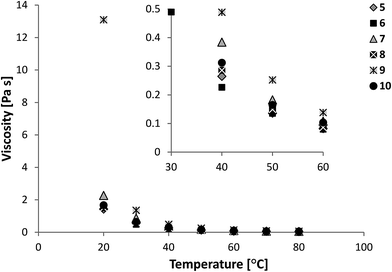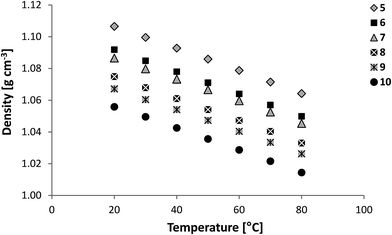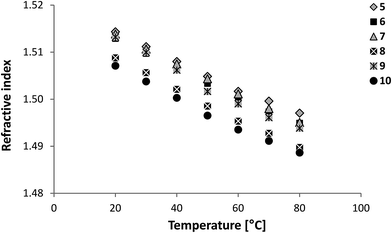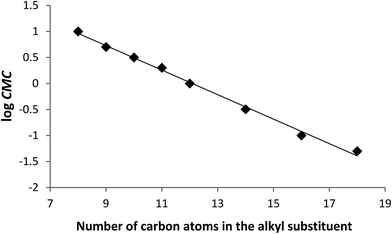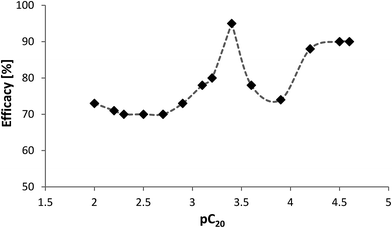Synthesis, properties and evaluation of biological activity of herbicidal ionic liquids with 4-(4-chloro-2-methylphenoxy)butanoate anion†
Juliusz Pernak*a,
Michał Niemczaka,
Katarzyna Maternaa,
Krzysztof Żelechowskib,
Katarzyna Marcinkowskac and
Tadeusz Praczykc
aDepartment of Chemical Technology, Poznan University of Technology, 60-965 Poznan, Poland. E-mail: juliusz.pernak@put.poznan.pl; Tel: +48-61-6653682
bInstitute of Industrial Organic Chemistry, 03-236 Warsaw, Poland
cInstitute of Plant Protection – National Research Institute, 60-318 Poznan, Poland
First published on 5th January 2016
Abstract
In this study, fourteen new herbicidal ionic liquids (HILs) based on MCPB with a 1-alkyl-1-methylpiperidinium cation were synthesized and characterized. The effect of the alkyl chain length on the physicochemical properties of HILs was determined. Additionally, thermal analysis, solubility in 10 representative solvents, and surface and herbicidal activity were determined. The herbicidal efficacy was tested in greenhouse experiments by using common lambsquarters (Chenopodium album L.) and oilseed rape (Brassica napus L.) as test plants. The ionic liquids were more effective than the commercial herbicide. Moreover, there was a relationship between the surface activity of HILs and herbicidal efficiency.
1. Introduction
Herbicidal ionic liquids (HILs) are ionic liquids defined as organic compounds with a melting temperature below 100 °C which contain ions that exhibit herbicidal activity.1 The discovery of HILs in 2011 showed that it was possible to obtain new phytopharmaceuticals that exhibit increased biological activity and multifunctional properties. This provided the opportunity to produce new formulations based on current herbicides, such as the derivatives of phenoxyacetic acid (2,4-D, MCPA and MCPP),1–4 benzoic acid (dicamba),5 clopyralid,6 fomesafen,7 glyphosate,8 metsulfuron methyl (MS-M),9 or bentazone.10 It is also possible to synthesize HILs that display two biological functions, for example, the HIL formed from the growth regulator 2-chloroethyltrimethylammonium cation with a MCPA11 or 2,4-D12 anion. The first advantage of HILs compared with commercial herbicidal formulations arises from their limited volatility.5 This eliminates the problem of contamination through air emissions. HILs allow the herbicide dose per hectare to be decreased and decrease herbicide toxicity; for example, toxic phenoxy herbicides may become nontoxic as HILs.1 HILs also possess unique physicochemical properties, including thermal stability, solubility, and surface activity. Additionally, the chemical structure of the cation may be modified to regulate the environmental impact, toxicity and biodegradability directly.13,14Furthermore, several reports show that ionic liquids can improve the immunity of plants to pathogenic factors, for example, by inducing plant systemic acquired resistance towards viral diseases15,16 or fungi.17 Recently protic ILs have been described as solvents for the solubilizing and stabilizing viruses.18
MCPB is a post-emergence systemic hormone-type herbicide (phenoxy carboxylic acid) for early control of annual and perennial broad-leaved weeds. It is selective for cereals, clovers, sainfoin, peas, peanuts, and grassland. It is absorbed by the leaves and roots, and is then translocated into plant tissues. In susceptible plants, MCPB is metabolically transformed to the corresponding 2-methyl-4-chlorophenoxyacetic acid (MCPA), but in resistant plants this process does not occur.19 MCPB demonstrates high efficacy against cresses, docks, fat hen, field bindweed, hedge mustard, redroot, shepherd's purse, and thistles. It degrades relatively quickly in soil (DT50 5–7 days), and it is moderately toxic to aquatic organisms. In the market, it is used mainly in combination with other herbicides. Many hormone-type herbicides, including MCPB, were discovered over 60 years ago, but they still play a major role in the herbicide resistance strategy and control of difficult weeds in cereal crops.20
Mepiquat chloride, widely used as a growth regulator, and its analogs can be used as sources of cations for ionic liquids. In this work, we synthesized MCPB-based ionic liquids with the 1-alkyl-1-methylpiperidinium cation as potential herbicides. We examined the effect of the length of the alkyl chain attached to the cation on the physicochemical properties, solubility, thermal stability, and the surface and biological activity of the HILs. Furthermore, the correlation between the herbicidal efficiency and the adsorption parameter, pC20, is also presented.
2. Experimental
2.1. Materials
Bromoethane 99%, 1-bromododecane 99%, 1-bromotetradecane 98%, 1-bromohexadecane 98.8%, and 1-methylpiperidine 99% were purchased from Merck. 1-Bromopropane 99%, 1-bromobutane 99%, 1-bromopentane 98%, 1-bromohexane 98%, 1-bromoheptane 99%, 1-bromooctane 99%, 1-bromononane 98%, 1-bromodecane 98%, 1-bromoundecane 98%, 1-bromooctadecane 97%, Dowex-Monosphere 550A anion exchange resin (OH), γ-butyrolactone 98%, and 4-chloro-2-methylphenol 97% were purchased from Sigma-Aldrich. All solvents, methanol, DMSO, acetonitrile, acetone, isopropanol, ethyl acetate, chloroform, toluene, hexane, and NaOH were purchased from Sigma-Aldrich (European market, Poznan, Poland) and used without further purification.2.2. Preparation of HILs
4-(4-Chloro-2-methylphenoxy)butanoic acid was prepared according to the procedure described in its patent.21 1-Alkyl-1-methylpiperidinium bromides were synthesized according to a previously described protocol.22 The reaction times were longer (48 h) and were not optimized. The experiments were conducted under an argon atmosphere. The crude product was dried under reduced pressure (20 mm Hg) at 50 °C for 10 h. An anion exchange resin (0.02 mol) and distilled water (200 mL) were placed in a 500 mL round-bottom flask equipped with a mechanical stirrer, and the suspension was vigorously stirred for 1 h. 1-Alkyl-1-methylpiperidinium bromide (0.01 mol) was added and an ion exchange reaction was conducted at room temperature for 5 h. The resin was filtered off and rinsed with small amounts of distilled water. 4-(4-Chloro-2-methylphenoxy)butanoic (MCPB) acid (0.01 mol) was gradually added to neutralize the 1-alkyl-1-methylpiperidinium hydroxide solution. The water was removed by using a rotary evaporator and the product was dried under reduced pressure (5 mm Hg) at 50 °C for 12 h.2.3. Methods
Density was determined by using an Automatic Density Meter DDM2911 with the mechanical oscillator method. The density of the samples (about 2.0 mL) was measured from 20 to 80 °C controlled with a Peltier heater. The apparatus was calibrated by using deionized water as the reference. After each series of measurements, the densimeter was washed with methanol and acetone and dried. Viscosity was determined by using a rheometer (Rheotec RC30-CPS) with cone-shaped geometry (C50-2). The viscosity of the samples (about 1.5 mL) was measured from 20 to 80 °C. The uncertainty of the viscosity measurement was estimated to be less than 10−4 Pa s. Refractive index was determined by using an Automatic Refractometer J357 with electronic temperature control.
![[thin space (1/6-em)]](https://www.rsc.org/images/entities/char_2009.gif) C by using a linear regression analysis method.
C by using a linear regression analysis method.Surface excess concentrations, Γmax, were calculated by using the Gibbs isotherm,  , where Γmax is the surface excess concentration at the saturated interface, R is the gas constant, T is the absolute temperature, and C is the salt concentration. From Γmax, the minimum surface occupied by a molecule at the interface Amin was calculated from
, where Γmax is the surface excess concentration at the saturated interface, R is the gas constant, T is the absolute temperature, and C is the salt concentration. From Γmax, the minimum surface occupied by a molecule at the interface Amin was calculated from  , where NA is the Avogadro number.
, where NA is the Avogadro number.
The contact angle was determined by the sessile drop method, where drops of liquid were deposited on a solid paraffin surface.
The HILs were dissolved in water and the plants were treated with the solution once at the 6- to 8-leaf growth stage. The HILs were applied with a moving sprayer (APORO, Poznan, Poland) by using a TeeJet VP 110/02 (TeeJet Technologies, Wheaton, IL, USA) with a flat-fan nozzle capable of delivering 200 L ha−1 of spray solution at an operating pressure of 0.2 MPa. The sprayer was moved 40 cm above the plants at a constant speed of 3.1 m s−1. The fresh weight of the plants was determined two weeks after treatment (2 WAT). Data were expressed as percent of fresh weight reduction compared with untreated plants. The Agriculture Research Management (ARM) package was used for the statistical calculations. Only normally distributed data was analyzed by analysis of variance (ANOVA).
3. Results and discussion
3.1. Synthesis and physicochemical properties
The 14 piperidinium salts presented in Table 1 were synthesized by using a two-step approach. The products contained a 1-alkyl-1-methylpiperidinium cation with an alkyl chain from ethyl to octadecyl. The first synthesis step was an ion-exchange reaction in an ion-exchange column, in which the halide anions were replaced with hydroxide ions. The second step was a direct acid–base reaction between the hydroxides and MCPB free acid in a 1![[thin space (1/6-em)]](https://www.rsc.org/images/entities/char_2009.gif) :
:![[thin space (1/6-em)]](https://www.rsc.org/images/entities/char_2009.gif) 1 stoichiometric ratio (Scheme 1). Finally, the products were dried under vacuum at 50 °C for 12 h and stored over P4O10.
1 stoichiometric ratio (Scheme 1). Finally, the products were dried under vacuum at 50 °C for 12 h and stored over P4O10.
| Salts | R | Yield (%) | Purity (%) | State at 25 °C |
|---|---|---|---|---|
| 1 | C2H5 | 93 | — | Wax |
| 2 | C3H7 | 94 | — | Wax |
| 3 | C4H9 | 96 | — | Wax |
| 4 | C5H11 | 95 | — | Wax |
| 5 | C6H13 | 92 | — | Liquid |
| 6 | C7H15 | 91 | — | Liquid |
| 7 | C8H17 | 93 | 99 | Liquid |
| 8 | C9H19 | 92 | 99 | Liquid |
| 9 | C10H21 | 91 | 98 | Liquid |
| 10 | C11H23 | 94 | 98 | Liquid |
| 11 | C12H25 | 93 | 99 | Wax |
| 12 | C14H29 | 91 | 98 | Wax |
| 13 | C16H33 | 93 | 98 | Wax |
| 14 | C18H37 | 92 | 97 | Wax |
All salts were obtained in high yields exceeding 90%. The purity of the salts with long alkyl chains (7–14) was determined via direct two-phase titration, which determined the amount of surface-active substance in the product well. The synthesized salts had high purities (Table 1) from 97% for 14 to 99% for 7, 8 and 11. Additionally, elemental analysis results confirmed the identity and purity of the salts.
Structures of the piperidinium salts were confirmed by 1H and 13C NMR spectroscopy. Descriptions of the NMR spectra and the elemental analysis results for salts 1–14 are provided in the ESI (Fig. S1–S28†). The water content in the product was determined by Karl-Fischer measurements and was less than 1000 ppm for all salts. Furthermore, all products were stable in air, water, and the tested organic solvents. The concentration and colour of the solutions of the salts were constant over a period of two weeks.
Eight salts (1–4, 11–14) were waxes and six (5–10) were liquids at room temperature. None of the synthesized salts underwent phase transfer to the solid state at 100 °C; therefore, they were classified as ionic liquids (ILs). Moreover, ILs 5–10 were room temperature ionic liquids (RTILs) owing to their low melting points. Their physicochemical properties, such as viscosity, density and refractive index, were determined from 20 to 80 °C, and they are presented in Fig. 1–4. The collected physicochemical data are provided in the ESI in Tables S1–S3.†
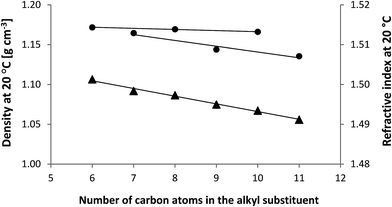 | ||
| Fig. 4 Relationship between density (▲) or refractive index (●) and the chain length of obtained ILs (5–10) at 20 °C. | ||
The effect of temperature on the viscosity values for ILs 5–10 is presented in Fig. 1. At 20 °C, the viscosity of the salts varied from 1.429 Pa s for compound 5 to 13.094 Pa s for 9. Although several reports24,25 show that the viscosity increases as the size of the non-polar part of the cations increases, this phenomenon was not observed for the obtained ILs. All ILs exhibited similar viscosity values between 1.429 and 2.270 Pa s, except 9, which exhibited a viscosity value that was several times larger (ESI, Table S1†). A similar trend was observed for HILs with another phenoxyacetate anion (MCPA). There was also no relationship between the increase in the length of the alkyl or alkoxymethyl chains in the ammonium cation and the viscosity. Therefore, the highest values in the homologous series were HILs with tetradecyl and octyloxymethyl substituents.4 This specific behaviour may be connected with the altered coordinating ability of the phenoxycarboxylate anions compared with conventional, structurally simpler anions.
Furthermore, viscosities of the ILs were higher compared with most known piperidinium ILs. For example, values ranging from 0.108 to 0.481 Pa s at 20 °C were reported for bis(trifluoromethylsulfonyl)imides, which have been extensively studied for electrochemical applications.26,27 For the other ILs, the viscosity decreased nonlinearly with increasing temperature. Hence, an increase in temperature from 20 to 80 °C caused a rapid reduction in viscosity, which was between 0.041 and 0.058 Pa s.
The density of RTILs (5–10) was higher than the density of pure water (Fig. 2). Values determined at 20 °C ranged from 1.056 g cm−3 for 10 to 1.107 g cm−3 for 5 and were similar to other previously described ILs.4,13 The densities for the ILs were temperature-dependent and linearly decreased with an increase in temperature. Hence, a temperature increase from 20 to 80 °C decreased the density by about 0.04 g cm−3 for all salts (ESI, Table S2†). Moreover, Fig. 4 shows that density of the studied ILs linearly decreased with elongation of the alkyl chain. The chain extension by one carbon atom resulted in a slight decrease (about 0.01 g cm−3) in density, which is consistent with the literature data.28,29
ILs are often characterized by higher refractive index values than conventional solvents. The indices were mostly in the range from 1.40 to 2.20 depending on the structures of the cation and anion.30–32
The refractive index values of the synthesized ILs (5–10) at 20 °C ranged from 1.507 for 10 to 1.514 for 5 (ESI, Table S3†). Similar to the density measurements, the increase in the temperature caused a slight linear decrease of the refractive index values, as shown in Fig. 3. Finally, at 80 °C the refractive indices were lower by about 0.018 and reached values below 1.500 for all compounds. Furthermore, the results show that the elongation of alkyl substituent decreased the refractive index (Fig. 4). This phenomenon has been reported, but mainly for imidazolium ILs.32 Surprisingly, there were two linear relationships between refractive index at 20 °C and the chain length of the alkylpiperidinium ILs. The first relationship, characterized by a small regression line slope (y = −0.00028x + 1.516; R2 = 0.99), was observed for products comprising an even number of carbon atoms in the alkyl chain (ILs 5, 7, 9 with 6, 8, and 10 carbon atoms, respectively). Compounds with an odd number of carbon atoms (ILs 6, 8, 10 with 7, 9, and 11 carbon atoms, respectively) were characterized by a second line with a larger slope (y = −0.00145x + 1.523; R2 = 0.95), which resulted in their lower refractive indices compared with ILs 5, 7 and 9. Only three points in the regression line were not sufficient for us to confirm our hypothesis of linearity, and the determined values may be the result of error. However, an increase in the alkyl length affects the refractive index values differently from other physicochemical properties, indicating that this dependence requires further research.
3.2. Thermal analysis
Thermal gravimetric analysis (TGA) and differential scanning calorimetry (DSC) data for the ILs are presented in Table 2. Six (5–10) of the ILs were liquids below 20 °C. For three ILs (5, 7, 8), neither melting nor crystallization events were observed in the temperature range analysed. The lowest melting point was noted for 10 (Tm = −27.3 °C), which also exhibited a crystallization event at 23.0 °C during cooling. ILs with shorter (1–4) or longer (11–14) alkyl substituents melted at slightly higher temperatures between 36.5 °C for 11 and 64.3 °C for 3. This characteristic behaviour of ILs has been described repeatedly in the literature.33,34 Nevertheless, all the salts exhibited a melting point below 100 °C, and were classified as ILs. The differences between the crystallization temperatures of the salts were small and ranged from −4.5 °C for 13 to 20.3 °C for 10. However, the results were diverse and did not show a clear effect of the alkyl chain length on this parameter. Surprisingly, two crystallization events (Tc = 6.1/19.5 °C) were observed during cooling of 14. This result might be attributed to the high molecular weight and the long alkyl chain substituent attached to the ammonium cation, and may be linked to the formation of two different crystalline structures.| ILs | R | Tma (°C) | Tcb (°C) | Tgc (°C) | Steps of degradation | Tonset5%d (°C) | Tonsete (°C) |
|---|---|---|---|---|---|---|---|
| a Tm – melting point.b Tc – temperature of crystallization.c Tg – glass transition temperature.d Tonset5% – decomposition temperature of 5% sample.e Tonset – decomposition temperature. | |||||||
| 1 | C2H5 | 40.3 | −2.7 | −31.2 | 1 | 187 | 254 |
| 2 | C3H7 | 59.6 | 16.2 | −32.8 | 1 | 184 | 252 |
| 3 | C4H9 | 64.3 | 7.5 | −29.2 | 1 | 158 | 243 |
| 4 | C5H11 | 39.9 | −2.8 | −36.1 | 1 | 154 | 252 |
| 5 | C6H13 | — | — | −35.4 | 2 | 197 | 260 |
| 6 | C7H15 | 19.7 | 4.5 | −32.1 | 2 | 190 | 262 |
| 7 | C8H17 | — | — | −42.1 | 2 | 170 | 224 |
| 8 | C9H19 | — | — | −41.2 | 3 | 196 | 272 |
| 9 | C10H21 | 18.6 | 17.4 | −40.0 | 3 | 188 | 284 |
| 10 | C11H23 | −27.3 | 23.0 | −39.7 | 4 | 205 | 305 |
| 11 | C12H25 | 36.5 | 8.9 | −43.8 | 4 | 215 | 327 |
| 12 | C14H29 | 59.9 | 11.4 | −20.9 | 2 | 197 | 314 |
| 13 | C16H33 | 46.4 | −4.5 | −12.1 | 2 | 210 | 347 |
| 14 | C18H37 | 46.3 | 6.1/19.5 | 1.6 | 3 | 213 | 367 |
Analysis of structure as a function of the glass transition relationships revealed a known trend; the longer the alkyl chain substituent attached to the nitrogen atom, the lower the glass transition of the resulting IL. However, the changes of the glass transition temperatures resulting from the difference in the length of the alkyl chain were generally smaller than those of the melting temperatures. The rapid decrease of glass transition temperatures with increasing alkyl chain length was caused by the elongation of the molecular chain, which disrupted the crystal packing and reduced the lattice energy.35,36 The further increase of the alkyl chain length increased the attractive van der Waals interactions and led to a significant increase in melting points and glass transitions. This observation has already been reported for ammonium or imidazolium ILs.33,37,38 Therefore, the lowest glass transition temperature (Tg = −43.8 °C) was observed for the 11 with the 1-dodecyl-1-methylpiperidinium cation and along with the increase of the alkyl chain length there is an increase of this phase transition. Consequently, the glass transition temperatures for 12, 13 and 14 were −20.9, −12.1 and 1.6 °C, respectively.
Only ILs 1–4 containing a short alkyl substituent exhibited simple thermal decomposition behaviour with a single decomposition step (Table 5). However, the other ILs were characterized by a two-, three- or even four-step decomposition, which was directly connected to the partial decomposition of alkyl chains attached to the nitrogen atom. Thermograms of ILs 1 (1 °C steps), 5 (2 °C steps), 9 (3 °C steps), (12) (2 °C steps), 14 (3 °C steps) are presented in Fig. 5. The lowest decomposition temperatures, Tonset5%, were observed for ILs with a butyl (4) and a pentyl (5) group of 158 and 154 °C, respectively. Moreover, Tonset5% appeared to be related to the length and molecular weight of the R substituent. Hence, temperatures exceeding 200 °C were observed for ILs possessing an undecyl or longer group. This trend is also visible in Fig. 5, where the decomposition temperatures (Tonset) increase with the increase in the length of the alkyl chain. Generally, it was consistent with data collected for other HILs.4 However, according to published reports, the decomposition temperatures can be mainly independent of the alkyl chain length of some ammonium or imidazolium ILs.38,39 Surprisingly, the lowest decomposition temperature (Tonset) was observed for the IL with the octyl group (7) (Tonset = 224 °C), and was approximately 40 °C lower than the values obtained for the other ILs with a medium-length alkyl chain (6, 8). However, 13 and 14 exhibited the highest thermal stability, and thus their Tonset values were 347 and 367 °C, respectively.
| ILs | Water | Methanol | DMSO | Acetonitrile | Acetone | Isopropanol | Ethyl acetate | Chloroform | Toluene | Hexane |
|---|---|---|---|---|---|---|---|---|---|---|
| 1 | + | + | + | + | + | + | − | + | − | − |
| 2 | + | + | + | ± | + | + | ± | + | − | − |
| 3 | + | + | + | ± | + | + | ± | + | − | − |
| 4 | + | + | + | − | + | + | ± | + | ± | − |
| 5 | + | + | + | − | + | + | + | + | + | − |
| 6 | + | + | + | − | + | + | + | + | + | − |
| 7 | + | + | + | − | + | + | + | + | + | − |
| 8 | + | + | + | − | + | + | + | + | + | − |
| 9 | + | + | + | + | + | + | + | + | + | − |
| 10 | + | + | + | + | + | + | + | + | + | − |
| 11 | + | + | + | + | + | + | + | + | + | − |
| 12 | + | + | + | + | + | + | − | + | + | − |
| 13 | ± | + | + | + | + | + | − | + | + | − |
| 14 | − | + | + | + | + | + | − | + | + | − |
| ILs | CMC (mmol L−1) | γCMC (mN m−1) | Γmax × 106 (mol m−2) | Amin × 1019 (m2) | CA (°) | pC20 |
|---|---|---|---|---|---|---|
| 1 | 31.4 | 42.9 | 5.25 | 3.28 | 77.4 | 2.0 |
| 2 | 29.7 | 41.2 | 5.85 | 3.09 | 74.2 | 2.2 |
| 3 | 28.3 | 40.8 | 6.03 | 2.75 | 76.6 | 2.3 |
| 4 | 27.7 | 42.7 | 6.86 | 2.42 | 72.2 | 2.5 |
| 5 | 23.5 | 41.6 | 6.75 | 2.14 | 75.8 | 2.7 |
| 6 | 22.1 | 41.2 | 6.43 | 1.96 | 70.8 | 2.9 |
| 7 | 19.9 | 37.1 | 6.47 | 2.27 | 62.5 | 3.1 |
| 8 | 5.01 | 36.1 | 6.53 | 2.41 | 59.6 | 3.2 |
| 9 | 3.16 | 35.0 | 6.62 | 2.21 | 56.0 | 3.4 |
| 10 | 2.00 | 34.4 | 8.47 | 1.96 | 55.3 | 3.6 |
| 11 | 1.00 | 33.5 | 9.86 | 1.68 | 53.0 | 3.9 |
| 12 | 0.32 | 33.6 | 7.91 | 2.11 | 52.4 | 4.2 |
| 13 | 0.10 | 35.5 | 6.84 | 2.43 | 53.1 | 4.5 |
| 14 | 0.08 | 35.8 | 7.11 | 2.34 | 52.5 | 4.6 |
| ILs | Ra | Efficacy [%] | ||
|---|---|---|---|---|
| Common lambsquarters | Oilseed rape | |||
| a All compounds were used at a dose of 600 g of active ingredient per 1 ha; the same letter in the column means no statistically significant differences. | ||||
| 1 | C2H5 | 83 | 73 | cd |
| 2 | C3H7 | 73 | 71 | cd |
| 3 | C4H9 | 71 | 70 | d |
| 4 | C5H11 | 77 | 70 | d |
| 5 | C6H13 | 79 | 70 | d |
| 6 | C7H15 | 81 | 70 | d |
| 7 | C8H17 | 79 | 78 | bcd |
| 8 | C9H19 | 77 | 80 | bcd |
| 9 | C10H21 | 88 | 95 | a |
| 10 | C11H23 | 82 | 83 | abc |
| 11 | C12H25 | 85 | 82 | bcd |
| 12 | C14H29 | 86 | 88 | ab |
| 13 | C16H33 | 80 | 90 | ab |
| 14 | C18H37 | 75 | 90 | ab |
| MCPA – salt | 70 | 70 | d | |
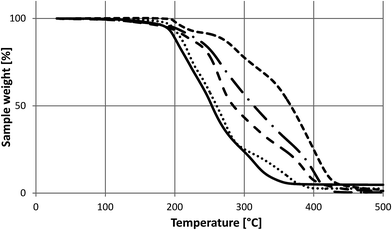 | ||
Fig. 5 TGA thermogram of ILs, where ( ) – 1 (Tonset: 254 °C); ( ) – 1 (Tonset: 254 °C); ( ) – 5 (Tonset: 260 °C); ( ) – 5 (Tonset: 260 °C); ( ) – 9 (Tonset: 284 °C); ( ) – 9 (Tonset: 284 °C); ( ) – 12 (Tonset: 314 °C); ( ) – 12 (Tonset: 314 °C); ( ) – 14 (Tonset: 367 °C). ) – 14 (Tonset: 367 °C). | ||
3.3. Solubility
The solubilities of the ILs were tested in 10 representative solvents, varying from high to low polarity. The solvents were selected based on a decreasing order of Snyder polarity index: water, 9.0; methanol, 6.6; DMSO, 6.5; acetonitrile, 6.2; acetone, 5.1; isopropanol, 4.3; ethyl acetate, 4.3; chloroform, 4.1; toluene, 2.3; hexane, 0.0. The results are presented in Table 3. As expected, almost all the ILs were soluble in the most polar solvents, such as water, methanol and DMSO. Only two ILs, possessing the longest alkyl substituents (13 and 14) were hydrophobic. This result suggests that the presence of an alkyl chain comprising more than 14 carbon atoms in MCPB-based HILs reduces the water solubility. This observation may be particularly useful for controlling groundwater mobility in a new herbicide.The slightly less polar aprotic solvents acetone and isopropanol also dissolved all ILs regardless of their carbon chain length. Interestingly, only ILs with alkyl groups from pentyl to nonyl (4–8) were insoluble in acetonitrile. This means that a decrease or increase in the alkyl chain length improved the affinity to this solvent. Ethyl acetate showed the opposite behaviour, where ILs comprising medium-length alkyl chains (5–11) dissolved easily. Thus, IL 2, 3 and 5 demonstrated limited solubility and the rest (1, 12–14) were insoluble. Despite similar Snyder polarity index values (4.3) of isopropanol and ethyl acetate, the effect of carbon alkyl length on solvent affinity was different. Owing to the ionic bonds in the structure of ILs, the semipolar protic solvent, isopropanol, was a better diluent than the aprotic semipolar ester, ethyl acetate.
The common chlorinated solvent, chloroform, dissolved all the ILs despite its relatively low polarity. Moreover, all the ILs were insoluble in nonpolar hexane and the majority (5–14) were soluble in toluene. The presence of a short-chain substituent attached to the piperidinium cation hindered the solubility in this nonpolar solvent. The differences in the solubility of HILs in the three least polar solvents may be explained by their dielectric constants. The results confirm that the hypothesis that ionic liquids are generally immiscible with liquids possessing low dielectric constants. Therefore, none of the obtained HILs dissolved in hexane (εr = 1.9) and the some of them were miscible with toluene (εr = 2.4). Chloroform, which had the highest dielectric constant (εr = 4.8), dissolved HILs the most effectively.23,40
3.4. Surface activity
The surface-active properties of the ILs are summarized in Table 4. The surface activity of ionic liquids can be evaluated by γCMC, which is the effectiveness of surface tension reduction. For aqueous solutions of the ILs, the surface tension decreased from the value of water value to a minimum between 33.5 and 42.9 mN m−1. For 1–6, the solutions had the highest γCMC values from 40.8 to 42.9 mN m−1. This demonstrated that ILs with longer alkyl substituents exhibited larger intermolecular hydrophobic interactions, making it easier to form aggregates in water as the length of the substituent increased.The CMC value decreased from 1 to 14 as expected from the increased hydrophobicity owing to the elongation of the hydrocarbon chain (Fig. 6). The area per molecule, Amin, values were lowest for 10 and 11, indicating that molecules of 10 and 11 were more tightly packed at the water–air interface.
The adsorption efficiency, pC20, is defined as the negative logarithm of the surface-active compound concentration in the bulk phase required to reduce the surface tension of the water by 20 mN m−1. Thus, the greater the pC20 value, the higher the adsorption efficiency of the surface-active compound. The efficiency of adsorption of a surface-active compound at the surface, as measured by the pC20 value, increased linearly with an increase in the number of carbon atoms in the hydrophobic chain.
For wetting, the reduction of the contact angle of the drop from 77.4° to 70.8° was observed for 1–6, and to 62.5–52.4° for 7–14 (Table 4). Better wettability of the paraffin surface, which is similar to the surface of plants, was observed for MCPB salts and may be useful in future applications of these ILs as herbicides.
3.5. Herbicidal activity
The greenhouse tests carried out with common lambsquarters and oilseed rape plants showed good efficacy of all ILs used at a dose equivalent of 600 g a.i. per 1 ha. Because MCPB is converted to MCPA in susceptible plants, the efficacy of tested ILs was compared with commercial product containing MCPA salt. Data in Table 5 indicate that the level of weed control depended on the weed species and tested compound, and, in many cases, the differences between HILs were not significant.ILs with shorter aliphatic chain were characterized by a slightly lower activity than those with longer alkyl chains, especially for the oilseed rape control. The most active compound was 9, which exhibited an efficacy of 95%, although 10, 12, 13 and 14 also gave good results. Statistical analysis showed that the differences between these compounds were not significant. The biological activity of ILs was similar to or better than commercial herbicide; therefore, the homologous series of compounds can be classified as new herbicidal ionic liquids.
The effectiveness of ILs was dependent on their structure and weed species. The trends for common lambsquarters and oilseed rape were similar. In both cases, a considerable improvement in the effectiveness can be observed when 9 was applied. This IL exhibited a significant decrease in the critical micelle concentration compared with ILs with a shorter aliphatic chain. Surface tension is an important parameter affecting the surface properties of compounds. The low value of this parameter characterizes ILs with good surface properties. ILs 9–14 exhibited desirable surface tensions (33.6–35.8 mN m−1). The high efficacy of these ILs was observed for oilseed rape. The herbicidal activity observed for oilseed rape as a function of the pC20 is shown in Fig. 7. The bulk liquid phase concentration of the surfactant required to decrease the surface tension of the solvent by 20 mN m−1 is a good measure of the efficiency of adsorption of ILs. The efficiency of sorption of an IL on a surface can be related to its herbicidal efficacy. As the length of hydrophobic chain increased, the herbicidal activity increased. For HILs with the shortest chains, variation was observed in higher efficiency for 1 and 2 than for 3–8. This can be explained mainly by the action of the anion and the negligible effect of the cation on the relevant parameter. The maximum value of the herbicidal efficacy was recorded for 9 (R = C10H21). For substituents containing more than 10 carbon atoms (10 and 11), the results were surprisingly low, presumably due to excessive foaming. The values of efficacy for 12–14 were slightly lower than for 9, probably because of their lower solubility in water, and remained stable at a similar high level (88–90%).
4. Conclusions
In this study, new MCPB-based ionic liquids with a 1-alkyl-1-methylpiperidinium cation were synthesized and characterized by 1H and 13C NMR spectroscopy. The physicochemical properties of the obtained salts (viscosity, density, refractive index values, and solubility) were affected by the length of alkyl chain attached to the cation. The TGA and DSC analyzes confirmed that all the salts were thermally stable and exhibited melting points below 100 °C. Furthermore, the herbicidal activity of the salts towards common lambsquarters and oilseed rape was similar or better compared with the commercial herbicide (MCPA salt; herbicidal efficacy at 70%); therefore, they can be classified as HILs. It was established that HILs containing longer alkyl chains (C10–C18) exhibited higher herbicidal activity (80–95%), whereas those with shorter alkyl chains (C2–C9) were less efficient (70–80%), which was especially clear during tests on oilseed rape. The best results were obtained after treatment with the HIL containing the decyl chain (R = C10H21), which also displayed potent surface-active properties. Thus, it was possible to correlate the herbicidal efficiency with the adsorption parameter, pC20. These findings provide fundamental structural and functional information for the synthesis of efficient crop protection agents for future applications.Acknowledgements
This work was supported by grant PBS2/A1/9/2013. The National Centre for Research and Development, Warszawa, Poland.References
- J. Pernak, A. Syguda, D. Janiszewska, K. Materna and T. Praczyk, Tetrahedron, 2011, 67, 4838 CrossRef CAS.
- T. Praczyk, P. Kardasz, E. Jakubiak, A. Syguda, K. Materna and J. Pernak, Weed Sci., 2012, 60, 189 CrossRef CAS.
- J. Pernak, A. Syguda, K. Materna, E. Janus, P. Kardasz and T. Praczyk, 2,4-D based herbicidal ionic liquids, Tetrahedron, 2012, 68, 4267–4273 CrossRef CAS.
- R. Kordala-Markiewicz, H. Rodak, B. Markiewicz, F. Walkiewicz, A. Sznajdrowska, K. Materna, K. Marcinkowska, T. Praczyk and J. Pernak, Tetrahedron, 2014, 70, 4784 CrossRef CAS.
- O. A. Cojocaru, J. L. Shamshina, G. Gurau, A. Syguda, T. Praczyk, J. Pernak and R. D. Rogers, Green Chem., 2013, 15, 2110 RSC.
- J. Zhu, G. Ding, Y. Liu, B. Wang, W. Zhang, M. Guo, Q. Geng and Y. Cao, Chem. Eng. J., 2015, 279, 472 CrossRef CAS.
- G. Ding, Y. Liu, B. Wang, D. Punyapitak, M. Guo, Y. Duan, J. Li and Y. Cao, New J. Chem., 2014, 38, 5590 RSC.
- J. Pernak, M. Niemczak, R. Giszter, J. L. Shamshina, G. Gurau, O. A. Cojocaru, T. Praczyk, K. Marcinkowska and R. D. Rogers, ACS Sustainable Chem. Eng., 2014, 2, 2845 CrossRef CAS.
- J. Pernak, M. Niemczak, J. L. Shamshina, G. Gurau, G. Głowacki, T. Praczyk, K. Marcinkowska and R. D. Rogers, J. Agric. Food Chem., 2015, 13, 3357 CrossRef PubMed.
- B. Wang, G. Ding, J. Zhu, W. Zhang, M. Guo, Q. Geng, D. Gou and Y. Cao, Tetrahedron, 2015, 71, 7860 CrossRef CAS.
- J. Pernak, M. Niemczak, K. Zakrocka and T. Praczyk, Tetrahedron, 2013, 69, 8132 CrossRef CAS.
- J. Pernak, M. Niemczak, K. Materna, K. Marcinkowska and T. Praczyk, Tetrahedron, 2013, 69, 4665 CrossRef CAS.
- J. Pernak, K. Czerniak, M. Niemczak, Ł. Chrzanowski, Ł. Ławniczak, P. Fochtman, K. Marcinkowska and T. Praczyk, New J. Chem., 2015, 39, 5715 RSC.
- M. Niemczak, R. Giszter, K. Czerniak, K. Marcinkowska and F. Walkiewicz, RSC Adv., 2015, 5, 15487 RSC.
- M. Smiglak, R. Kukawka, P. Lewandowski and H. Pospieszny, Tetrahedron Lett., 2014, 55, 3565 CrossRef CAS.
- P. Lewandowski, R. Kukawka, H. Pospieszny and M. Smiglak, New J. Chem., 2014, 38, 1372 RSC.
- K. Bica, L. R. Cooke, P. Nugent, C. Rijksen and R. D. Rogers, Green Chem., 2011, 13, 2344 RSC.
- N. Byrne, B. Rodoni, F. Constable, S. Varghese and J. H. Davis Jr, Phys. Chem. Chem. Phys., 2012, 14, 10119 RSC.
- J. Stenersen, Chemical Pesticides Mode of Action and Toxicology, CRC press, 2004 Search PubMed.
- A. M. Ballingall, Julius-Kühn-Archiv, 2014, vol. 443, p. 268 Search PubMed.
- B. J. Heywood, US Pat., 2866816, 1958.
- A. Triolo, O. Russina, B. Fazio, G. B. Appetecchi, M. Carewska and S. Passerini, J. Chem. Phys., 2009, 130, 164521 CrossRef PubMed.
- A. I. Vogel, B. S. Furniss, A. J. Hannaford, P. W. G. Smith and A. R. Tatchell, Textbook of Practical Organic Chemistry, Wiley John & Sons Inc, New York, 1989 Search PubMed.
- T. Y. Wu, S. G. Su, S. T. Gung, M. W. Lin, Y. C. Lin, W. C. Ou-Yang, I. W. Sun and C. A. Lai, J. Iran. Chem. Soc., 2011, 8, 149 CrossRef CAS.
- H. Tokuda, K. Hayamizu, K. Ishii, M. A. B. H. Susan and M. Watanabe, J. Phys. Chem. B, 2005, 109, 6103 CrossRef CAS PubMed.
- K. C. Lethesh, K. Van Hecke, L. Van Meervelt, P. Nockemann, B. Kirchner, S. Zahn, T. N. Parac-Vogt, W. Dehaen and K. Binnemans, J. Phys. Chem. B, 2011, 115, 8424 CrossRef CAS PubMed.
- T. Yim, Y. L. Hyun, H.-J. Kim, J. Mun, S. Kim, S. M. Oh and G. K. Young, Bull. Korean Chem. Soc., 2007, 28, 1567 CrossRef CAS.
- J. Jacquemin, P. Husson, A. A. Padua and V. Majer, Green Chem., 2006, 8, 172 RSC.
- C. Kolbeck, J. Lehmann, K. R. J. Lovelock, T. Cremer, N. Paape, P. Wasserscheid, A. P. Fröba, F. Maier and H.-P. Steinrück, Density and Surface Tension of Ionic Liquids, J. Phys. Chem. B, 2010, 114, 17025 CrossRef CAS PubMed.
- N. V. Plechkova and K. R. Seddon, Chem. Soc. Rev., 2008, 37, 123 RSC.
- S. Seki, S. Tsuzuki, K. Hayamizu, Y. Umebayashi, N. Serizawa, K. Takei and H. Miyashiro, J. Chem. Eng. Data, 2012, 57, 2211 CrossRef CAS.
- M. Tariq, P. A. S. Forte, M. F. Costa Gomes, J. N. Canongia Lopes and L. P. N. Rebelo, J. Chem. Thermodyn., 2009, 41, 790 CrossRef CAS.
- P. Wasserscheid and T. Welton, Ionic Liquids in Synthesis, Wiley-VCH, Weinheim, 2002 Search PubMed.
- S. Zhang, N. Sun, X. He, X. Lu and X. Zhang, J. Phys. Chem. Ref. Data, 2006, 35, 1475 CrossRef CAS.
- F. Faridbod, H. Rashedi, M. R. Ganjali, P. Norouzi and S. Riahi, Application of room temperature ionic liquids in electrochemical sensors and biosensors, INTECH Open Access Publisher, 2011 Search PubMed.
- J. Wang, A. Zhu and L. Li, in Sustainable Catalytic Processes, ed. B. Saha, M. Fan and J. Wang, Elsevier, 2015, ch. 3, pp. 61–98 Search PubMed.
- T. Erdmenger, J. Vitz, F. Wiesbrock and U. S. Schubert, J. Mater. Chem., 2008, 18, 5267 RSC.
- K. Machanová, Z. Wagner, A. Andresová, J. Rotrekl, A. Boisset, J. Jacquemin and M. Bendová, J. Solution Chem., 2015, 44, 790 CrossRef.
- W. H. Awad, J. W. Gilman, M. Nyden, R. H. Harris Jr, T. E. Sutto, J. Callahan, P. C. Trulove, H. C. De Long and D. M. Fox, Thermochim. Acta, 2004, 409, 3 CrossRef CAS.
- M. Freemantle, An Introduction to Ionic Liquids, RSC Publishing, Royal Society of Chemistry, Cambridge, 2009, pp. 44–46 Search PubMed.
Footnote |
| † Electronic supplementary information (ESI) available. See DOI: 10.1039/c5ra23997d |
| This journal is © The Royal Society of Chemistry 2016 |


